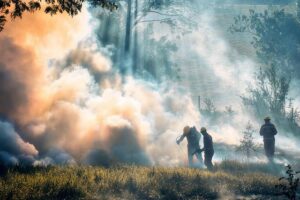The Iroquois Theater Fire: A Tragic Catalyst for Fire Safety Reform
A Night of Devastation: The 1903 Iroquois Theater Blaze
On the evening of December 30, 1903, Chicago witnessed one of the most catastrophic theater fires in U.S.history at the Iroquois Theater. What started as a minor electrical fault behind the stage rapidly escalated into a deadly inferno, fueled by flammable stage decorations and inadequate safety measures. Within moments,the theater was engulfed in flames and thick smoke,trapping over 1,900 attendees inside during a holiday performance. The disaster resulted in more than 600 fatalities and left hundreds injured, marking it as one of the deadliest single-building fires in American history.
This tragedy exposed severe shortcomings in fire safety protocols and building regulations of the era, including locked emergency exits and the absence of fire suppression systems. The aftermath ignited public outrage and led to sweeping reforms in fire safety standards nationwide.
Root Causes: Unveiling the Safety Failures Behind the Disaster
Investigations into the Iroquois Theater fire revealed a series of critical safety lapses that compounded the disaster’s severity.The theater’s electrical wiring was outdated and poorly maintained, which caused the initial spark that ignited the highly combustible stage curtains and scenery. Compounding the danger, many emergency exits were either locked or obstructed to prevent unauthorized entry, effectively trapping patrons inside during the emergency.
Additional factors that worsened the situation included:
- Flammable materials: The extensive use of untreated wood and fabric accelerated the fire’s spread.
- Absence of fire alarms: No early warning systems were in place to alert the audience promptly.
- Lack of staff preparedness: Employees were not trained in emergency evacuation procedures, leading to confusion and panic.
| Safety Aspect | 1903 Theater Condition | Contemporary Standards |
|---|---|---|
| Emergency Exits | Only three,many locked or hidden | Multiple,clearly marked,unlocked exits |
| Fire-Resistant Materials | Minimal use; curtains and sets highly flammable | Mandatory use of fire-retardant fabrics and materials |
| Fire Detection Systems | None installed | Automated alarms and smoke detectors required |
| Staff Training | No formal emergency drills | Regular fire drills and emergency response training |
Voices from the Flames: Survivor Accounts of Courage and Tragedy
Amid the chaos,survivors’ testimonies reveal both the harrowing human cost and remarkable acts of bravery. Eyewitnesses recounted desperate attempts to escape through narrow aisles and locked doors, with many succumbing to smoke inhalation and trampling. Yet, stories of heroism emerged, highlighting individuals who risked their lives to save others.
- Clara Thompson: “I watched a man carry an elderly woman on his back, refusing to abandon her despite the growing flames.”
- Samuel Reed: “The smoke was suffocating, but ushers tore down curtains blocking exits, giving many a chance to flee.”
- Helen Martinez: “Strangers formed human chains to guide children and the elderly through the panic.”
| Name | Role | Heroic Deed |
|---|---|---|
| James O’Connor | Theater Usher | Removed barricades from emergency exits |
| Margaret Ellis | Audience Member | Provided water and comfort to trapped victims |
| William Harris | Firefighter | Rescued unconscious patrons from smoke-filled areas |
Transforming Tragedy into Progress: Fire Safety Reforms Inspired by the Iroquois Fire
The devastating loss of life at the Iroquois Theater served as a wake-up call, prompting comprehensive changes in fire safety legislation and building codes. Lawmakers mandated that all public venues must have multiple, clearly marked emergency exits that open outward and remain unlocked during events to facilitate rapid evacuation. The use of fire-resistant materials in construction and stage design became compulsory, significantly reducing the risk of rapid fire spread.
Furthermore, the tragedy underscored the importance of installing reliable fire detection and alarm systems, and also conducting regular evacuation drills to prepare both staff and patrons for emergencies. These reforms have been instrumental in preventing similar disasters in theaters and other public spaces across the United States.
| Issue Addressed | Implemented Reform | Resulting Benefit |
|---|---|---|
| Locked Emergency Doors | Exit doors must remain unlocked and accessible | Enables quick and safe evacuation |
| Exit Door Design | Installation of outward-swinging,push-bar doors | Prevents crowd congestion and bottlenecks |
| Building Materials | Mandatory use of fire-retardant fabrics and materials | Slows fire progression |
| Fire Detection and Alarms | Compulsory installation of automated alarm systems | Improves early warning and response |
| Emergency Preparedness | Regular fire drills and staff training required | Enhances readiness and reduces panic |
| Occupancy Regulations | Strict enforcement of maximum capacity limits | Prevents overcrowding and facilitates evacuation |
Reflecting on the Legacy: Why the Iroquois Theater Fire Still Matters
The Iroquois Theater fire remains a poignant reminder of the devastating consequences that can arise from neglecting fire safety and emergency preparedness. As one of the deadliest theater fires in American history, it not only claimed hundreds of lives but also served as a catalyst for vital reforms that have saved countless others since. Today, the lessons learned continue to inform fire safety codes, emergency planning, and public awareness campaigns, ensuring safer environments in theaters, concert halls, and other crowded venues.
Honoring the memory of those lost in this tragedy reinforces the ongoing commitment to vigilance, innovation, and education in fire prevention and safety management.








